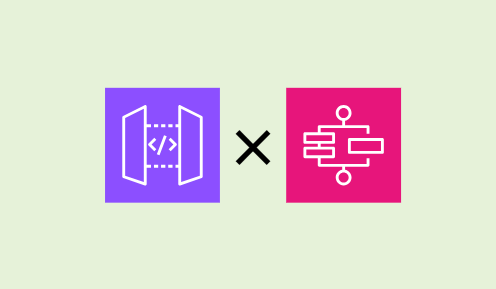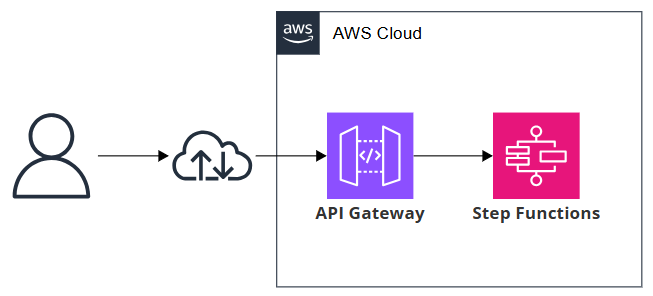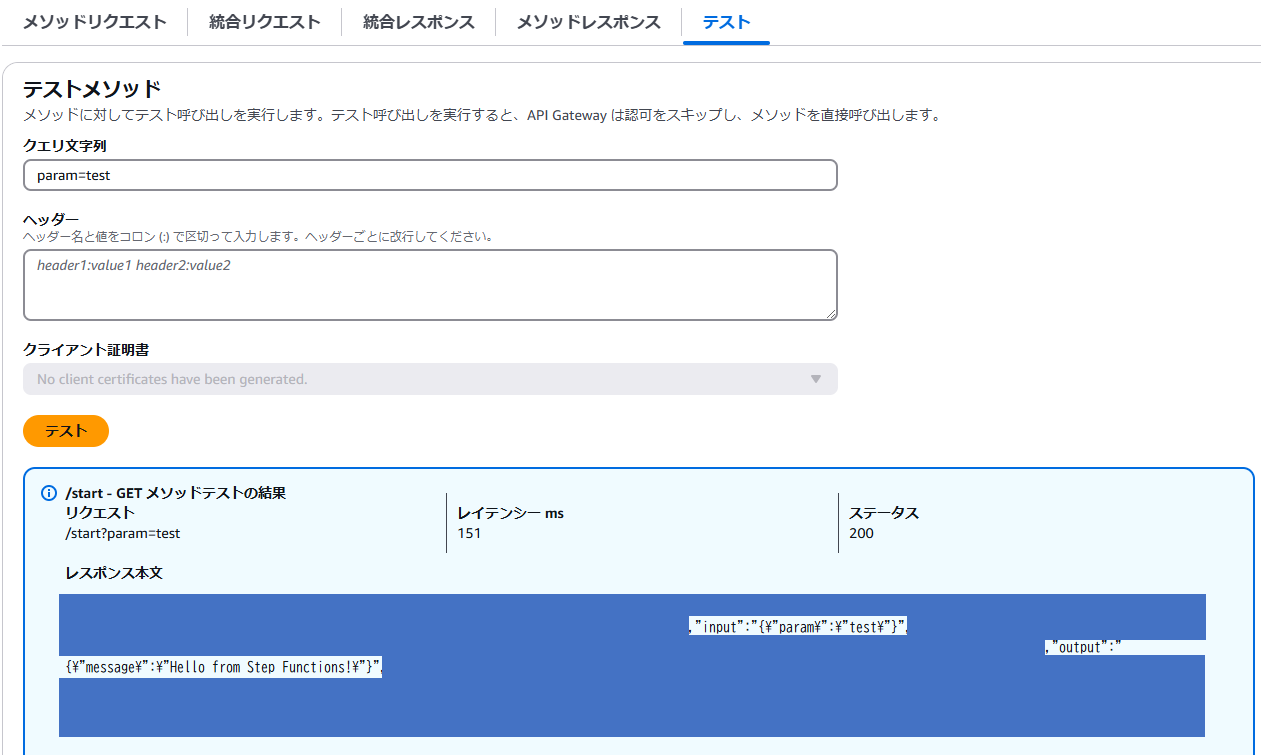- 公開日
- 最終更新日
API Gateway から Step Functions を直接呼び出す方法
この記事を共有する

目次
はじめに
こんにちは、パーソル&サーバーワークスの小竹です。
社内研修でのサーバーレスシステム構築時に、API Gatewayから直接AWS Step Functionsを呼び出す方法を調べたので、本記事にまとめてみました!
構成概要
本構成では、API Gatewayを使用してHTTPリクエストを受け取り、Step Functionsのステートマシンを起動します。
Step Functionsのステートマシンは、Expressワークフローを使用して同期的に実行され、処理結果をAPI Gatewayを通じてクライアントに返すような構成となっています。

CloudFormationコード
CloudFormationのサンプルコードを添付しました。
上記、構成図通りのリソースが作成されます。
ここを押すと展開します
AWSTemplateFormatVersion: '2010-09-09'
Description: API Gateway (GET) → Step Functions (Express) with CloudWatch Logs
Resources:
StepFunctionLogGroup:
Type: AWS::Logs::LogGroup
Properties:
LogGroupName: !Sub "/aws/vendedlogs/states/${AWS::StackName}-statemachine"
RetentionInDays: 7
StepFunctionsExecutionRole:
Type: AWS::IAM::Role
Properties:
RoleName: !Sub "StepFunctions-${AWS::StackName}-role"
Path: /service-role/
MaxSessionDuration: 3600
AssumeRolePolicyDocument:
Version: '2012-10-17'
Statement:
- Effect: Allow
Action: sts:AssumeRole
Principal:
Service: states.amazonaws.com
ManagedPolicyArns:
- arn:aws:iam::aws:policy/AWSXRayDaemonWriteAccess
- arn:aws:iam::aws:policy/AmazonS3FullAccess
Policies:
- PolicyName: AllowStepFunctionsLogs
PolicyDocument:
Version: '2012-10-17'
Statement:
- Effect: Allow
Action:
- logs:*
Resource: "*"
MyStateMachine:
Type: AWS::StepFunctions::StateMachine
DependsOn: StepFunctionLogGroup
Properties:
StateMachineName: !Sub "${AWS::StackName}-MyStateMachine"
StateMachineType: EXPRESS
RoleArn: !GetAtt StepFunctionsExecutionRole.Arn
LoggingConfiguration:
Destinations:
- CloudWatchLogsLogGroup:
LogGroupArn: !GetAtt StepFunctionLogGroup.Arn
IncludeExecutionData: true
Level: ALL
DefinitionString: |
{
"StartAt": "HelloWorld",
"States": {
"HelloWorld": {
"Type": "Pass",
"Result": {
"message": "Hello from Step Functions!"
},
"End": true
}
}
}
# API Gateway 実行ロール(Step Functions実行権限)
ApiGatewayExecutionRole:
Type: AWS::IAM::Role
Properties:
AssumeRolePolicyDocument:
Version: '2012-10-17'
Statement:
- Effect: Allow
Principal:
Service: apigateway.amazonaws.com
Action: sts:AssumeRole
Policies:
- PolicyName: AllowStepFunctionsStart
PolicyDocument:
Version: '2012-10-17'
Statement:
- Effect: Allow
Action: states:StartSyncExecution
Resource: !Ref MyStateMachine
# API Gateway 本体
MyApi:
Type: AWS::ApiGateway::RestApi
Properties:
Name: StepFunctionsApi
MyResource:
Type: AWS::ApiGateway::Resource
Properties:
ParentId: !GetAtt MyApi.RootResourceId
PathPart: start
RestApiId: !Ref MyApi
MyMethod:
Type: AWS::ApiGateway::Method
Properties:
HttpMethod: GET
ResourceId: !Ref MyResource
RestApiId: !Ref MyApi
AuthorizationType: NONE
Integration:
Type: AWS
IntegrationHttpMethod: POST
Uri: !Sub >-
arn:aws:apigateway:${AWS::Region}:states:action/StartSyncExecution
Credentials: !GetAtt ApiGatewayExecutionRole.Arn
RequestTemplates:
application/json: !Sub |
#set($data='{"param":"'+$input.params('param')+'"}')
#set($data=$util.escapeJavaScript($data))
{
"input" :"$data",
"stateMachineArn": "${MyStateMachine}"
}
IntegrationResponses:
- StatusCode: 200
ResponseTemplates:
application/json: "$input.body"
RequestParameters:
method.request.querystring.example: false
MethodResponses:
- StatusCode: 200
MyDeployment:
Type: AWS::ApiGateway::Deployment
DependsOn: MyMethod
Properties:
RestApiId: !Ref MyApi
StageName: prod
Outputs:
ApiEndpoint:
Description: API Endpoint to start Step Functions (GET /start?example=value)
Value: !Sub "https://${MyApi}.execute-api.${AWS::Region}.amazonaws.com/prod/start?example=value"
構成のポイント
- Express ワークフローで低レイテンシ処理を実現
- Lambdaを使わずに API Gateway → Step Functions を直接連携
- Step Functionsのログを有効化し、ステートマシンの実行内容を可視化
- StartSyncExecution を使用し、同期的にレスポンスを取得
1. Step Functions(Express)ステートマシン
🧩 構成のポイント: Express ワークフローによる低レイテンシ処理
StateMachineType: EXPRESS を指定することで、ステートマシンはミリ秒単位で実行され、API連携に適した構成になります。 Express型は短時間処理・高頻度呼び出しに最適で、同期実行にも対応しているのが特徴です。
今回のケースでは、DynamoDBクエリ処理など軽量な業務処理が想定されていたため、Express型を採用しました。
StateMachineType: EXPRESS2. CloudWatch Logsへの出力設定
🧩 構成のポイント: Step Functionsのログを有効化し、ステートマシンの実行内容を可視化
ステートマシンに LoggingConfiguration を追加し、Level: ALL と IncludeExecutionData: true を設定することで、各ステップの入力・出力やエラー内容をCloudWatch Logsに出力できます。
デバッグや監視にも役立ちます。
LoggingConfiguration:
Level: ALL
IncludeExecutionData: true3. API Gateway → Step Functions の統合
🧩 構成のポイント: StartSyncExecutionを使い、同期的にレスポンスを取得
API Gateway から Step Functions を直接呼び出すには、統合タイプを AWS、IntegrationHttpMethod を POST に設定し、URI に StartSyncExecution を指定します。
これにより、Step Functions の実行が完了するまで待ち、結果を API レスポンスとして返すことができます。
Uri: arn:aws:apigateway:${AWS::Region}:states:action/StartSyncExecution4. IAMロール(API Gateway用)
🧩 構成のポイント: Lambdaを使わずにAPI GatewayからStep Functionsへ直接連携
API Gateway から Step Functions を呼び出すには、適切な IAM ロールを設定する必要があります。以下のように states:StartSyncExecution を許可します。
Action: states:StartSyncExecution5. API Gateway 設定(テンプレート)
🧩 構成のポイント: Lambdaを使わずにAPI GatewayからStep Functionsへ直接連携
リクエストテンプレートで、クエリパラメータを JSON に変換し、Step Functions に渡します。
また、マッピングテンプレートは、Velocity Template Language (VTL)という言語で記載する必要があります。
RequestTemplates:
application/json: |
#set($data='{"param":"'+$input.params('param')+'"}')
#set($data=$util.escapeJavaScript($data))
{
"input" :"$data",
"stateMachineArn": "${MyStateMachine}
}「stateMachineArn」にステートマシンのARNを定義することで、対象のステートマシンが実行されるようになります。
また、パラメータを整形することで、クライアントからの入力をそのままStep Functionsに渡せます。
6. 動作確認
API Gatewayからテストを実施
API Gatewayのテストにて、クエリ文字列「param=test」を指定して実行しました。
レスポンス本文にて、inputとoutputが正常に出力されていることを確認できました。
Curlコマンドでの動作確認
コマンドプロンプトからもAPI Gatewayのテストと同じ結果が返されることが確認できました。

まとめ
API GatewayからStep Functionsを直接呼び出す構成により、Lambdaを挟まずにシンプルなAPIを実現できました。
今回の構成で特に苦労したのは、API Gatewayのマッピングテンプレートの記述です。
Velocity Template Language (VTL)は初めて触れましたが、リクエストやレスポンスの整形に不可欠なため、業務で活用するには基礎からしっかり理解しておく必要があると感じました。
この記事は私が書きました
小竹 巧朗
記事一覧AWS認定 全冠目指して勉強中です! 趣味はスノボとゴルフです。
